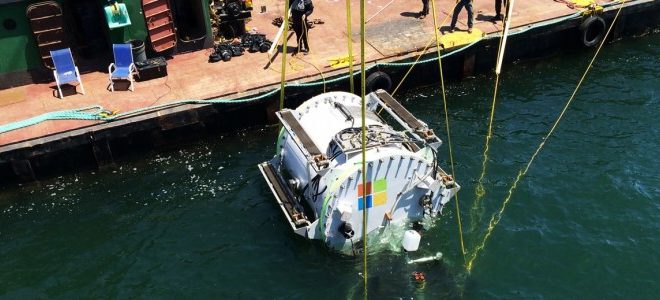Microsoft said yesterday it had submerged a second experimental data center off the coast of Scotland. as part of its Natick project that studies less energy-intensive data centers. While the idea in itself is a very good one—data centers consume huge amounts of energy for cooling—the environmental consequences of a wide adoption of such data centers are yet to be identified. and not all of them may be good.
It’s all about temperatures. really. The notorious energy intensity of data centers was the main reason why Microsoft began working on Natick. whose goal is to study the “manufacturing and operating environmentally sustainable. prepackaged datacenter units that can be ordered to size. rapidly deployed and left to operate lights out on the seafloor for years.“
The experimental data center is as large as a shipping container. at 12.2 m in length and a diameter of 3.18 m and contains 12 racks with a total 864 servers. It has a capacity of 27.6 petabytes. which Microsoft equates to storage space for five million movies and the power of several thousand high-end PCs. It also consumes 240 kW of electricity. all sourced from renewable sources including wind. solar. tidal. and wave. since the data center is located in the European Marine Energy Center.
Now let’s imagine thousands of such data centers being submerged into the sea around the world. What will the environmental effects of such mass adoption of energy-efficient data centers be? Will it actually help the environment by reducing onshore electricity needs. or will it damage it?
A typical data center consumes only a small portion of the energy it receives from the grid for useful work. The rest—and it is a lot at up to 98 percent—is released in the form of heat. Now. this heat could be reused by linking the data centers to heat-consuming facilities such as household heating grids. It’s not a universal solution. however. since heat is easily lost when it has to be transported from its place of origin. for example. and it is often not hot enough to be used as an alternative to conventional heating methods.
To solve the heat problem of their data centers. majors companies are looking for ways to reduce their cooling costs—pretty high due to the scale of their data center networks—by sending these data centers to cooler parts of the world. “Cooler“ is the keyword when it comes to submerged systems such as Microsoft’s Natick.
The North Sea is unquestionably a good place for a submerged data center. Yet not all seas are as cold as the North Sea. and that’s just one potential issue with the mass implementation of submerged data centers. Another. much bigger issue is the very fact of the heat: it does not disappear just because the data center is underwater. It is still generated and the more data centers there are underwater. the more heat is generated.
The world’s oceans are already getting warmer. One—or a dozen—submerged data centers will hardly worsen the situation. but start thinking in hundreds or thousands. and their effect on water temperatures near the coasts becomes more pronounced.
All this falls within the sphere of conjecture for now. Microsoft’s stated purpose with the Natick initiative was to study the possibilities of an environmentally friendly. economical application of modular underwater data centers. It’s way too early to worry about any major impact on the environment. Let’s first see how it goes with the Northern Isles data center.
 Iran Energy News Oil, Gas, Petrochemical and Energy Field Specialized Channel
Iran Energy News Oil, Gas, Petrochemical and Energy Field Specialized Channel




